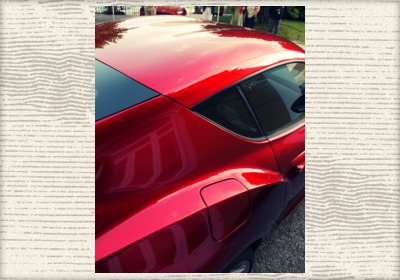First Sight: BMW Zagato Coupé
Thu, 31 May 2012"I've been looking for a way to collaborate with Zagato and Nori [Norihiko Harada, Chief Designer Zagato] for around 20 years," explains Adrian van Hooydonk, Senior Vice President BMW Group Design as we stand in the shadow of the magnificent Villa Erba. "Last year at this event we had a conversation and decided that it was the right time to do something."
BMW and Zagato both have history associated with the Concorso d'Eleganza Villa d'Este – Europe's most glamorous car show – yet until last weekend the two illustrious names had never crossed paths. The BMW Zagato Coupé marks the first project between the two and the first Italian-designed car to wear the blue and white propeller since the 2003 Bertone Birusa. "This collaboration is not a marketing collaboration, it's a design collaboration," van Hooydonk says as we look across to the Z4-based coupe. "It's absolutely in tune with the history of concourse; it's the haute couture of car design."
In an age where the brand message of large multi-nationals is such a carefully managed entity it's refreshing that BMW has the confidence to give up some of that control by linking up with a creative partner. The result is a car that is clearly a BMW yet couldn't have been created solely in Munich. If some of the usual fastidiousness has been lost – BMW would have spend months ironing out the Zagato Coupé's door shut tolerances and obsessing over its slightly unresolved tail - the payoff is an exoticism and bravado that could only come from a carrozzeria.
Of all the Italian design houses, Zagato has arguably the most distinctive design language – the double-bubble roof, the high, fastback Kamm tail and full, blown surfaces – yet here it's balanced with enough BMW-ness –precision, Kidney grille, short overhangs – to make it feel authentic to both companies.
"For Zagato it was an opportunity to push ourselves beyond what we usually do, and for BMW too," explains a beret-wearing Norihiko Harada, who we find hanging out on the steps of the villa with Andrea Zagato and his wife Marella. "Sometimes one plus one equals two. But when we work with BMW one plus one equals much more than that."
So just how difficult was it to strike the right balance between BMW and Zagato; between Germanic rationalism and Italian passion? "Honestly it was very easy," says van Hooydonk. "If you do a collaboration it has to be two-way, so this was very much a conversation. We had three meetings where I suggested some changes but these guys are great – you have to see Nori's sketchbook."
Harada concurs that the project, which started in October last year was pain-free: "We all have a love for cars and not all my favourite cars are Zagatos. I love BMWs too and if I love something I have to show it respect."
For BMW this was an opportunity to create a product that it didn't already have in its range – a compact, exclusive coupé that has the ability to be nostalgic in a way its relentlessly avantgarde core range of cars cannot legitimately be. For Zagato, clearly the opportunity to work with a company such as BMW is great for business; "a dream come true," comments Marella Zagato. But she also highlights another aim the project has allowed the company to achieve: "if you look at the cars we usually build they're very expensive and from super-luxury brands, so they are always bought by wealthy, older men. This car gave us the opportunity to make something younger. I can see this car being driven by a career woman."
This is the reflected in the color and trim design, created by Marella herself – a gloriously rich red for the exterior, created by a black base coat, followed by a layer of metallic silver then six ultra-thin coats of red and, finally, two layers of clear coat – that pops in the Italian sun to accentuate the car's surfacing and the black and red interior with matching luggage in the fastback tail.
Like all of Zagato's cars, the Zagato Coupé is fully-functioning prototype, based on a Z4, which Harada explains has been designed to be production-feasible.
When asked if this is the start of a new relationship, van Hooydonk smiles wryly: "Possibly. We're going to be showing the car at various events to gauge reaction."
That reaction isn't guaranteed to be universally positive – some will find it too retro, others will question its high-tail proportions but that's part of the freedom liberated by such projects. Marella sums it up: "it's better that not everybody likes it, but that somebody loves it."
By Owen Ready

